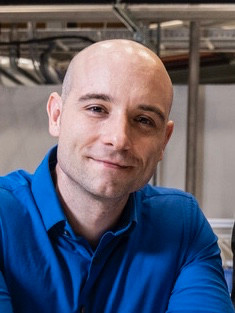

题目:New Mechanistic Insights in Heterogeneous Catalysis by Detection of Reactive Ketene Intermediates
时间:2024年5月6日 14:00-16:30
地点:hga010网页登录 F310会议室
邀请人:周忠岳 副教授(航空动力研究所)
Biography
 Patrick Hemberger is a principal investigator and beamline scientist at the vacuum ultraviolet (VUV) beamline at Paul Scherrer Institute. He obtained his PhD degree in physical chemistry from the University of Würzburg (Germany) with Ingo Fischer. Patrick develops and applies photoelectron photoion coincidence (PEPICO) techniques utilizing VUV synchrotron radiation to unveil reaction mechanisms at all states, time scales, and phases with a focus on heterogeneous catalysis. He received the Ruzǐcǩa Prize in Chemistry from ETH Zürich, was selected as a Mercator fellow by the German Science Foundation (DFG), and was recently recognized for his significant contributions to the research field of energy in the Rising Stars special issue of Energy and Fuels.
Patrick Hemberger is a principal investigator and beamline scientist at the vacuum ultraviolet (VUV) beamline at Paul Scherrer Institute. He obtained his PhD degree in physical chemistry from the University of Würzburg (Germany) with Ingo Fischer. Patrick develops and applies photoelectron photoion coincidence (PEPICO) techniques utilizing VUV synchrotron radiation to unveil reaction mechanisms at all states, time scales, and phases with a focus on heterogeneous catalysis. He received the Ruzǐcǩa Prize in Chemistry from ETH Zürich, was selected as a Mercator fellow by the German Science Foundation (DFG), and was recently recognized for his significant contributions to the research field of energy in the Rising Stars special issue of Energy and Fuels.
Abstract
Optimizing catalytic reactions typically involves adjusting temperature, pressure, concentration, or the catalyst properties to increase the conversion and the selectivity. However, if these “cook-and-look” approaches fail, a mechanistic understanding is crucial for rational optimization of the process. Detecting reactive intermediates like radicals and ketenes is challenging but essential for comprehending the reaction mechanism. In this talk, I will introduce operando Photoelectron Photoion Coincidence (PEPICO) spectroscopy with vacuum ultraviolet (VUV) synchrotron radiation as a rapid and sensitive detection tool for reaction intermediates, developed at the Swiss Light Source. PEPICO combines mass spectrometry and photoelectron spectroscopy to isomer-selectively identify and quantify intermediates and products in complex reaction mixtures.
We will discuss how this state-of-the-art detection tool gained new insights into catalytic fast pyrolysis (CFP) of lignin model compounds, such as methoxyphenols and benzenediols, over different zeolites. The formation of fulvenone (c-C5H4=C=O), a highly reactive ketene species, makes lignin CFP very unselective and yields multiple products, including substituted phenols and other hydrocarbons. Lowering the Si/Al ratio in the faujasite catalyst, increases the Brønsted acid site density, which effectively suppresses the fulvenone ketene formation and leads to a phenol selectivity increase by a factor of 5, rendering ketenes as unwanted intermediates during lignin catalytic pyrolysis.
If time permits, we will switch gears to explore the role of ketenes during the methanol-to-olefin (MTO) and propane oxidative dehydrogenation (ODHP) processes. We will show strong evidence that the simplest ketene (H2=C=O), ethenone, is responsible for the formation of the first olefins in MTO and helps to prevent overoxidation during ODHP.
